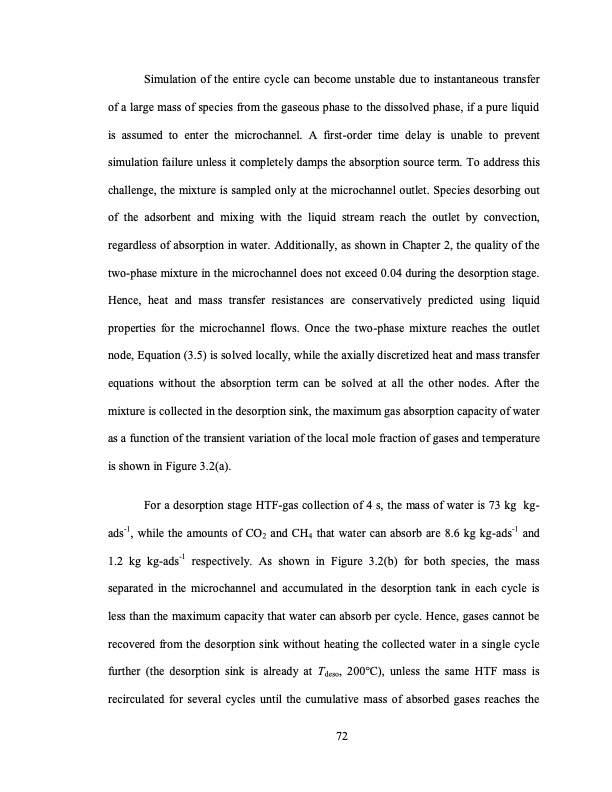
PDF Publication Title:
Text from PDF Page: 099
Simulation of the entire cycle can become unstable due to instantaneous transfer of a large mass of species from the gaseous phase to the dissolved phase, if a pure liquid is assumed to enter the microchannel. A first-order time delay is unable to prevent simulation failure unless it completely damps the absorption source term. To address this challenge, the mixture is sampled only at the microchannel outlet. Species desorbing out of the adsorbent and mixing with the liquid stream reach the outlet by convection, regardless of absorption in water. Additionally, as shown in Chapter 2, the quality of the two-phase mixture in the microchannel does not exceed 0.04 during the desorption stage. Hence, heat and mass transfer resistances are conservatively predicted using liquid properties for the microchannel flows. Once the two-phase mixture reaches the outlet node, Equation (3.5) is solved locally, while the axially discretized heat and mass transfer equations without the absorption term can be solved at all the other nodes. After the mixture is collected in the desorption sink, the maximum gas absorption capacity of water as a function of the transient variation of the local mole fraction of gases and temperature is shown in Figure 3.2(a). For a desorption stage HTF-gas collection of 4 s, the mass of water is 73 kg kg- ads-1, while the amounts of CO2 and CH4 that water can absorb are 8.6 kg kg-ads-1 and 1.2 kg kg-ads-1 respectively. As shown in Figure 3.2(b) for both species, the mass separated in the microchannel and accumulated in the desorption tank in each cycle is less than the maximum capacity that water can absorb per cycle. Hence, gases cannot be recovered from the desorption sink without heating the collected water in a single cycle further (the desorption sink is already at Tdeso, 200°C), unless the same HTF mass is recirculated for several cycles until the cumulative mass of absorbed gases reaches the 72PDF Image | TEMPERATURE SWING ADSORPTION PROCESSES FOR GAS SEPARATION

PDF Search Title:
TEMPERATURE SWING ADSORPTION PROCESSES FOR GAS SEPARATIONOriginal File Name Searched:
PAHINKAR-DISSERTATION-2016.pdfDIY PDF Search: Google It | Yahoo | Bing
CO2 Organic Rankine Cycle Experimenter Platform The supercritical CO2 phase change system is both a heat pump and organic rankine cycle which can be used for those purposes and as a supercritical extractor for advanced subcritical and supercritical extraction technology. Uses include producing nanoparticles, precious metal CO2 extraction, lithium battery recycling, and other applications... More Info
Heat Pumps CO2 ORC Heat Pump System Platform More Info
| CONTACT TEL: 608-238-6001 Email: greg@infinityturbine.com | RSS | AMP |